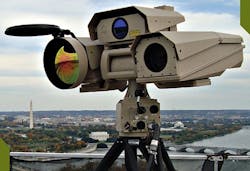Navy chooses long-range thermal cameras from FLIR Systems for air-to-ground range surveillance
Officials of the Range Systems Engineering Branch of the Naval Surface Warfare Center Corona Division in Norco, Calif., have announced their intention to negotiate a sole-source contract with FLIR Systems for several of the company's Ranger HRC cameras for air-to-ground training ranges and similar sensitive facilities.
The FLIR Ranger HRC electro-optical camera is a portable, long-range thermal-imaging surveillance system with multi-sensor options. The camera has a cooled ruggedized large-format 640-by-480-pixel indium antimonide infrared detector, autofocus, and 12.5X continuous zoom capability.
Related: Army chooses Talon multi-sensor system from FLIR Systems for UH-60 Black Hawk helicopter
The camera was designed for applications like force protection, border surveillance, tactical reconnaissance, training range applications, fixed and mobile security, target tracking, and long range surveillance.
Military personnel will use the cameras at the Juniper Butte and Saylor Creek ranges at Mountain Home Air Force Base, Idaho; Centennial and Red Rio ranges at Holloman Air Force Base, N.M.; Anwah, Badar, Fahad, and Khurais ranges in Saudi Arabia; Adirondack Range in Upstate New York; BT-11 Range at Cherry Point Marine Corps Air Station, N.C.; and Naval Surface Warfare Center Corona Division in Norco, Calif.
Military combat aircraft pilots use air-to-ground ranges to practice dropping bombs, firing missiles, and firing guns. Often pilots practice with inert munitions, but ranges can accommodate live-fire weapons practice when necessary.
The FLIR Systems Ranger HRC infrared camera is network-enabled, and uses the MPEG4 digital video format. It has long-range optics that are able to detect a man-sized target as far away as six miles, vehicle-sized targets more than 12 miles away.
Related: Compact, thermal imaging camera for industrial research introduced by FLIR Systems
The cameras have four times the resolution of mid-format systems for significantly greater range performance and image quality, FLIR officials say. The company's commercially developed, military qualified (CDMQ) process delivers a military quality system, designed to work 24/7/365.
The Ranger HRC system weighs less than 19 pounds, and measures 18.6 by 7.6 by 8.8 inches. Options include laser range finder, digital magnetic compass, and GPS-based geo-pointing and positioning.
For more information contact FLIR Systems online at www.flir.com or the Naval Surface Warfare Center Corona Division at www.navsea.navy.mil/nswc/corona.
